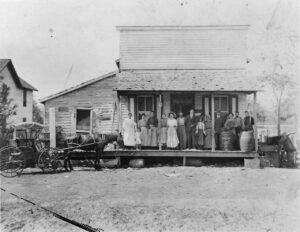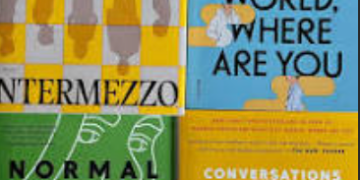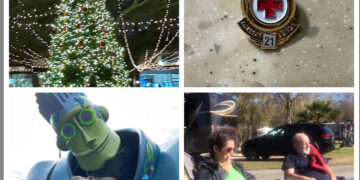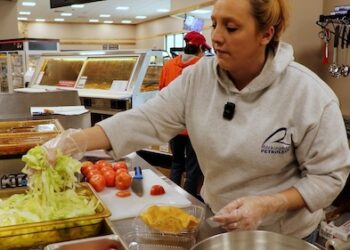Hoarding is one thing, but saving historic documents for the next generation is another. Lots of Brocks Gap families have treasures from generations back. Sometimes they might be hidden in the attic, like Leon and Judy Liskey discovered. Sometimes they may be stored in a box from grandma’s house that you just haven’t gotten around to unpacking.
Stacey Custer found six store account books from the store on Little Dry River owned by his great-great grandfather Jacob D. Custer (1861-1937). The customer list is a who’s who of Fulks Run and surrounding area from 1887-1904.
Jacob had over 300 customers, mainly relatives and neighbors. Fulk customers were most numerous, with 33. Other family groups were 30 Turners, 21 Ritchies, and 16 Millers. The Custer, Fawley, Hess, Hoover, and Reedy families had 11 customers each. Some other names were Albrite, Allen, Aubrey, Baker, Bare, Brady, Brenneman, Carr, Clutteur, Crider, Dove, Estep, Fitzwater, Grady, Hulvey, Keplinger, Lamb, Laurent, Mathias, May, Roadcap, Runion, Whitmer, Wine, and Wittig. (Tammy Fulk Cullers’ great-grandfather James L. Fulk was a customer and Jacob’s brother-in-law).

By comparing customer names for each year, you can get an idea of when families moved to and from Fulks Run. My Albrite family didn’t show up until 1903. Hint Caldwell appears only in 1897. “Squire” J. C. Cooper first appears in the 1888-89 book. His obituary confirmed that he moved to Fulks Run in 1888. Isabella Custer Mathias (Jacob Custer’s cousin) was widowed in 1896. She moved back to Fulks Run and had a store account in her name in 1897. (Few women had accounts in their own names).
E. D. Root, owner of a big logging business at Yankeetown, had an account from 1887-1892. About 1892, the business ran into hard times and closed, and he moved to Broadway. Some of his employees like McChessney, the Laurents, and perhaps J. W. Houck, had store accounts which also stopped after 1892.
Country store owners walked a fine line in letting their customers charge their orders. If too many charged without paying up, the store owner could go broke. Jacob must have been a good businessman, because he was a merchant for 54 years. Jacob accepted many forms of payment. Butter, egg, and chicken payments were common. Chicks, turkeys, ducks, rabbits (8ȼ), pheasants (25ȼ), grouse (8ȼ), beans, and chestnuts were also accepted.
Paying with bark and lumber was very common. In 1891, Allen J. Ritchie paid by bark seven times from October through December, with loads ranging from 1,840 to 2,150 pounds. Timothy Fulk brought in nine loads of bark from January-April, 1891. He got store credit for two of his loads, but Jacob paid him cash for seven loads. Jacob collected the bark and paid local men like Jerry Ritchie to haul it to Broadway. The Broadway Enterprise newspaper reported on Dec. 23, 1892, that there was plenty of bark and ties in the Gap, judging from the number of teams going to Broadway.
All of Jacob’s eight brothers and sisters shopped at his store. His carpenter brothers frequently bought large quantities of nails. Their father Berryman Custer hauled goods and bark for the store, and also paid his bill with [lumber] ties.
What could you buy at the store? Yard-goods for clothing were available. Since James Fitzwater bought 19 yards of cotton and 3 yards of flannel on one trip, his wife may have been sewing for others in the community. He paid his bill with rabbits, chickens, beans, wool, and cash. Miss Sallie Shickle also purchased a lot of fabric and thread. Ready-made clothing like shirts, socks, shoes, and boots were for sale. Davis Hess bought a “fine shirt” indicating that Jacob sold nice clothing in addition to work clothing. Boots cost different amounts, but the records don’t say if they were priced by size or by quality. Tin buckets, lemons (2 for a nickel), suspenders, thread, coffee, lard, crackers, syrup and candy were some interesting items. “Oil” was probably kerosene for lamps. (Even in the 1960s, some people referred to kerosene as “coal oil.”)
Jacob’s first wife Mary “Eva” Shickle died in 1894 a few months after her second child Dulaney “Laney” Custer was born. Midwife Sarah Fulk Fawley kept baby Laney and raised him. According to family stories, he was a small baby, and Sarah had her niece Sarah Martha Fawley milk enough cow’s milk into a tin cup for him to drink several times a day. The fresh warm cow’s milk was credited with making Laney strong enough to survive. The 1898-1900 store journal has eight pages of Sarah Fawley’s store purchases, all free. Jacob paid her by letting her have goods from the store.
What’s in your attic? You may discover community treasures like these store books.
































